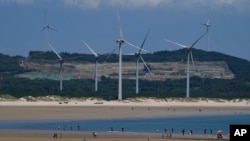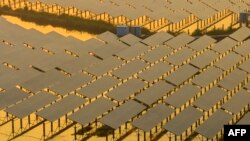During China’s annual national legislature this month, Premier Li Qiang announced plans to construct more solar and wind farms as well as hydropower projects.
China is already the world’s largest producer of renewable energy and also holds near-monopolies on the globe’s renewable energy manufacturing and supply chain. Last year alone China produced more solar panels than the U.S. has ever produced in total.
China’s dominance in electric vehicle battery components and solar power panels has rattled Western governments, including those of the European Union and the United States, which blame Beijing’s "huge" state subsidies. The U.S. has responded with its own subsidies and incentives to boost American production.
China is also the world’s biggest consumer of fossil fuels and the globe’s biggest emitter of carbon dioxide. But analysts say that puts Beijing in a good position to partner on renewable energy growth with a somewhat surprising group — oil producers in the Persian Gulf.
Gulf States including Saudi Arabia, the United Arab Emirates, Iran, Kuwait and Iraq produced about a third of the world’s crude oil in 2022, according to the U.S. Energy Information Administration. But they’re also diversifying away from those industries with help from China, say analysts.
Energy and Geopolitics Researcher Elai Rettig at Israel’s Bar-Ilan University tells VOA it’s a mutually beneficial investment as the shift to green energy will free up oil for sale to the Gulf’s main consumers in Asia, especially China.
"In that region, oil is cheaper than water," notes Rettig. "The more you invest in the Gulf, the more you can trust they’ll see you get oil even under sanctions. China is the biggest oil importer in the world and needs to make sure someone will sell them cheap oil if there’s a confrontation with the U.S."
But it’s less about the Gulf states’ love of China and more about Beijing’s ability to deliver on large-scale projects at lower costs, says Li-Chen Sim, a nonresident fellow at the Washington-based Middle East Institute.
"The Chinese can produce low-priced, polysilicon for solar panels because labor costs are cheaper, so products are cheaper. Solar model assembly in China is 50% cheaper than in Europe," she told VOA.
Western countries have raised tariffs on Chinese imports and offered fresh subsidies to encourage domestic competition. The European Union this month approved import taxes on Chinese electric vehicles and is considering them for solar panels.
The EU this month moved closer to banning products made with forced labor, which is expected to include polysilicon components for solar panels made in China’s western Xinjiang region, which supplies nearly half the global demand.
The United States stopped all imports from the region in 2022 as part of a crackdown on forced labor imposed on the region’s ethnic Uyghur Muslim minority, which China denies.
Despite pushback from the West, plunging solar prices are making it harder to compete with Chinese manufacturers.
Nonetheless, China has some competition when it comes to renewable energy in the Gulf States, says Sim.
"China plays a role [in the Gulf] in the financing, contractor and equipment sectors — in financing they are significant. But in fact, not as significant as the Japanese," she said. "Japan’s role in green energy financing in the Gulf is huge."
During his July 2023 Middle East tour aimed at promoting Japan’s green technology and regional economic ties, Japanese Prime Minister Fumio Kishida signed signed 23 agreements with the UAE to strengthen cooperation and existing partnerships.
Japan in 2017 became the first country in the world to formulate a national hydrogen strategy with plans to become the first "hydrogen society."
But it will have to compete with China, already the world’s top producer and consumer of hydrogen, though most of it is generated with high-carbon emission fossil fuels like coal.










